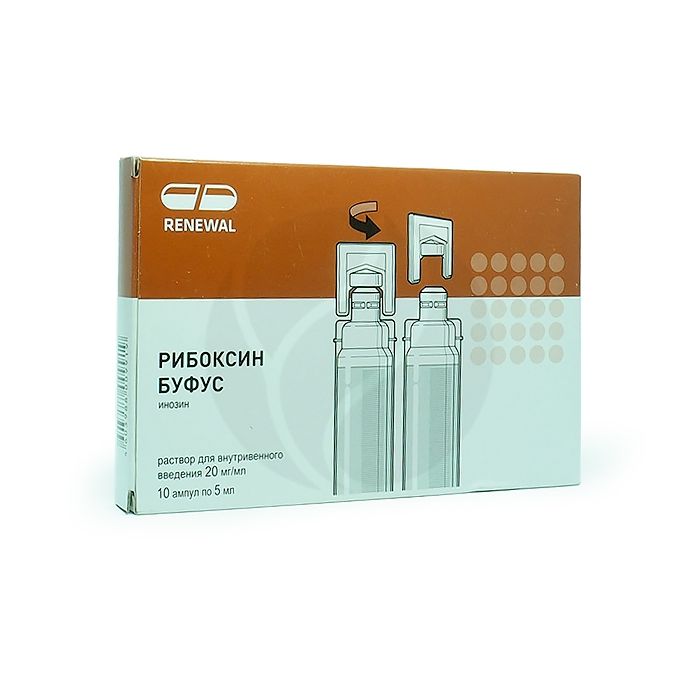Riboxin solution for injection 2%, No. 10 bufu
Expiration Date: 05/2027
Russian Pharmacy name:
Рибоксин раствор для инъекций 2%, №10 буфус
Complex treatment of myocardial infarction, ischemic heart disease, cardiac arrhythmias caused by the use of cardiac glycosides, against the background of myocardial dystrophy after infectious diseases.
Liver diseases (hepatitis, cirrhosis, fatty degeneration).
Surgery on an isolated kidney (as a means of pharmacological protection when the blood circulation is turned off).
The drug is administered intravenously in a slow stream or drip (40-60 drops per minute).
Treatment begins with the introduction of 200 mg (10 ml of a 2% solution) once a day, then, with good tolerance, the dose is increased to 400 mg (20 ml of a 2% solution) 1-2 times a day.
Duration of treatment is 10-15 days.
Jet injection of the drug is possible in acute heart rhythm disturbances in a single dose of 200-400 mg.
For the pharmacological protection of the kidneys subjected to ischemia, riboxin is injected intravenously in a stream, in a single dose of 1.2 g (60 ml of a 2% solution) 5-15 minutes before clamping the renal artery, and then another 0.8 g (40 ml of a 2% solution ) immediately after the restoration of blood circulation.
With drip injection into a vein, a 2% solution of the drug is diluted in 5% dextrose (glucose) solution or isotonic sodium chloride solution (up to 250 ml).
1 ml of solution contains:
active substance: inosine (riboxin) 20 mg,
excipients: propylene glycol, sodium hydroxide, sodium sulfite anhydrous, water for injection.
Hypersensitivity to the drug,
gout,
hyperuricemia,
pregnancy,
lactation period,
age up to 18 years (efficacy and safety have not been established).
Use with caution in renal failure.
Trade name: Riboxin
International non-proprietary name:
Inosine
Dosage form:
solution for intravenous administration.
Composition:
1 ml of solution contains:
active substance: inosine (riboxin) 20 mg,
excipients: propylene glycol, sodium hydroxide, sodium sulfite anhydrous, water for injection.
Description:
Colorless or slightly colored transparent liquid.
Pharmacotherapeutic group:
metabolic agent.
Pharmacological properties:
Riboxin - a derivative (nucleoside) of purine - a precursor of adenosine diphosphate ATP. Refers to a group of drugs that stimulate metabolic processes. It has antihypoxic and antiarrhythmic effects. Increases the energy balance of the myocardium, improves coronary circulation, prevents the consequences of intraoperative renal ischemia. It is directly involved in the metabolism of glucose and promotes the activation of metabolism in conditions of hypoxia and in the absence of ATP.
It activates the metabolism of pyruvic acid to ensure the normal process of tissue respiration, and also promotes the activation of xanthine dehydrogenase. Stimulates the synthesis of nucleotides, enhances the activity of certain enzymes of the Krebs cycle. Penetrating into cells, it has a positive effect on metabolic processes in the myocardium - it increases the strength of heart contractions and contributes to a more complete relaxation of the myocardium in diastole, as a result of which the stroke volume increases. The mechanism of antiarrhythmic action is not fully understood.
Reduces platelet aggregation, activates tissue regeneration (especially myocardium and gastrointestinal mucosa).
Pharmacokinetics
Metabolized in the liver with the formation of glucuronic acid and its subsequent oxidation. In small amounts excreted in the urine.
Indications for use
Complex treatment of myocardial infarction, coronary heart disease, cardiac arrhythmias caused by the use of cardiac glycosides, against the background of myocardial dystrophy after infectious diseases.
Liver diseases (hepatitis, cirrhosis, fatty degeneration).
Surgery on an isolated kidney (as a means of pharmacological protection when the blood circulation is turned off).
Contraindications
Hypersensitivity to the drug,
gout,
hyperuricemia,
pregnancy,
lactation period,
age up to 18 years (efficacy and safety have not been established).
Use with caution in renal failure.
Method of administration and dosage
The drug is administered intravenously in a slow stream or drip (40-60 drops per minute).
Treatment begins with the introduction of 200 mg (10 ml of a 2% solution) once a day, then, with good tolerance, the dose is increased to 400 mg (20 ml of a 2% solution) 1-2 times a day.
Duration of treatment is 10-15 days.
Jet injection of the drug is possible in acute heart rhythm disturbances in a single dose of 200-400 mg.
For the pharmacological protection of the kidneys subjected to ischemia, riboxin is injected intravenously in a stream, in a single dose of 1.2 g (60 ml of a 2% solution) 5-15 minutes before clamping the renal artery, and then another 0.8 g (40 ml of a 2% solution ) immediately after the restoration of blood circulation.
With drip injection into a vein, a 2% solution of the drug is diluted in 5% dextrose (glucose) solution or isotonic sodium chloride solution (up to 250 ml).
Side effect
Allergic reactions: itching, flushing of the skin (the drug should be canceled). Rarely: an increase in the concentration of uric acid in the blood, exacerbation of gout (with prolonged use).
Release form.
Solution for intravenous administration 20 mg / ml.
5 ml, 10 ml of the drug in ampoules of neutral glass with a notch marked with a dot (paint). 10 ampoules are placed in a blister made of polyvinyl chloride film. 1 blister strip together with instructions for use, scarifier or ampoule knife are placed in a cardboard box.
Storage conditions
In a dry, dark place at a temperature not exceeding 25 ? C. Keep out of the reach of children.
Shelf life is
3 years.
Do not use after the expiration date.
Terms of dispensing from pharmacies
Prescription.

